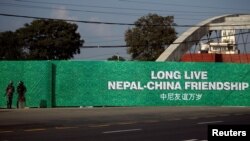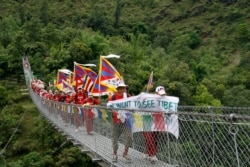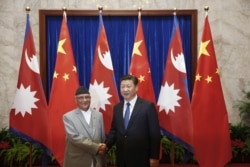The BBC recently reported on a leaked Nepalese government report accusing China of “encroaching into Nepal” by pushing into Nepal’s far-western Humla district, which borders the Tibetan Autonomous Region.
The Global Times, a mouthpiece for the Chinese Communist Party (CCP), disputed that claim in a report headlined, “BBC's China-Nepal border dispute hype a 'smear campaign’.”
The Global Times said the claims arose in 2020 but were “repeatedly refuted by the Nepali Ministry of Agriculture, Ministry of Foreign Affairs and Chinese Foreign Ministry.”
The paper cited a nameless “Nepalese investigator” who visited the area in 2020 and found the claims of Chinese encroachment “baseless.”
The Global Times also cited “insiders” who reportedly said Nepal’s Ministry of Home Affairs sent an inspection team to Humla district in September 2021. That was after “local anti-China, pro-India political forces” alleged Chinese encroachment, the paper said.
The same team submitted the report to Nepal’s Ministry of Home Affairs that the BBC cited. But Zhang Yongpan, an expert on border issues at the Chinese Academy of Social Sciences, told the Global Times the “report cannot represent the official position of Nepal.”
The BBC attributed more significance to the report, saying it marks, “the first time there have been official claims from Nepal of Chinese interference in its territory.”
Furthermore, the evidence cited in the report can’t be easily dismissed as a “smear campaign.” Although the remoteness of the border region and its inhospitable terrain complicate verification, the report’s findings fit into a broader pattern of alleged Chinese encroachment on territory in neighboring Bhutan and India.
The BBC notes that the 1,400 kilometers of mountainous border between China and Nepal is “demarcated by a chain of pillars, set kilometers apart.” This complicates efforts to determine the exact position of the border.
In September 2021, the Kathmandu Post reported that Nepal’s Ministry of Home Affairs had sent a team “to study border dispute issues with China.”
The newspaper reported that in 2020 that Jeevan Bahadur Shahi, then a member of the Karnali Provincial Assembly, had carried out his own investigation into Chinese encroachment.
Shahi alleged that China had replaced one border pillar “in such a way that a large chunk of Nepal’s territory had gone into China.”
The Kathmandu Post received portions of the September 2021 field study and reported on it the following month. The field study said “the Chinese side has put up wires and fencing in the Nepali territory.”
It added that China had attempted “to build a permanent canal 145 meters inside [of] Nepali territory.”
Nepalese police protested, and the canal’s structure was “destroyed,” the report said, adding “the covered rubble was visible.”
Citing the same report, the BBC said “Chinese security forces had restricted religious activities on the Nepalese side of the border,” as the area is a pilgrimage cite for both Buddhists and Hindus.
Keeping Tibetans from escaping into Nepal is one reason China is allegedly seeking greater control in the region.
Following the BBC story, Dal Rawal, an opposition lawmaker from Nepal’s Humla District, called on the federal government to release the September 2021 report.
In November 2020, the U.K.’s Daily Telegraph newspaper reported that the Chinese People’s Liberation Army (PLA) had seized land in five districts covering 150 hectares of Nepalese territory.
The Daily Telegraph said Beijing “employed similar tactics” when annexing at least 60 square kilometers of Indian territory in the Himalayan region of Ladakh, leading to the bloody, June 2020 Galwan River Valley border clash.
China’s Foreign Ministry said the information in the Telegraph report was based completely on rumors. The Daily Telegraph countered that the annexation had been “corroborated by fresh testimony from Nepalese villagers.”
Further complicating matters, a spokesperson for Nepal’s Foreign Ministry also denied the alleged annexation.
“It is not true that China has encroached our land and had constructed buildings there,” Reuters quoted Sewa Lamsal, a spokeswoman for Nepal’s Foreign Ministry, as saying.
But Shahi told Reuters that Chinese troops had built nine concrete structures one kilometer inside of Nepal in Humla.
The Global Times is correct that Nepal’s Ministry of Agriculture and Ministry of Foreign Affairs refuted reports of Chinese encroachment. But those denials came after a 2017 survey document from the Ministry of Agriculture surfaced alleging China had encroached on 36 hectares of Nepalese territory, the Himalaya Times reported.
Indian media seized on that report in the summer of 2020 to drum up claims of Chinese expansion.
K.P. Sharma Oli, who served three terms as Nepal’s prime minister, during the period from October 2015 to July 2021, has come under fire for his alleged pro-Beijing bias. Oli, a communist party leader, sought closer ties with China and took a more competitive stance against India.
Writing in South Asian Voices, a Washington, D.C.-based online policy platform, John Pollock said few democratic countries were as close geographically or as inclined politically, as Nepal was to China under K.P. Sharma Oli.”
He said Nepal’s heavy pivot toward Beijing was intended to offset “a perceived over-reliance on India.”
Santosh Sharma Poudel, co-founder of the Nepal Institute for Policy Research, said the Nepali Congress Party, which formed a minority government in July, criticized “China’s interventions in Nepal’s domestic politics.”
Indian media were more direct in their accusations. The Times of India claimed in August 2020 that China was getting “safe passage to occupy Nepal territory” with support from Oli.
Oli told the New Delhi-based broadcaster WION Nepal was in no position "to claim the territory of China or India," adding, "We must claim our own territory."
He further denied there were any Chinese checkposts on Nepal's northern border, adding, " [We] will not allow them [China] to put their military checkposts inside our territory."
The Times of India, which has a pro-India, anti-China slant, also cited the report from the Survey Department of Nepal’s Agriculture Ministry.
The paper alleged the scope of encroachment was being “underreported” and the Nepali Communist Party was “trying to shield the expansionist agenda of the Chinese Communist Party.”







